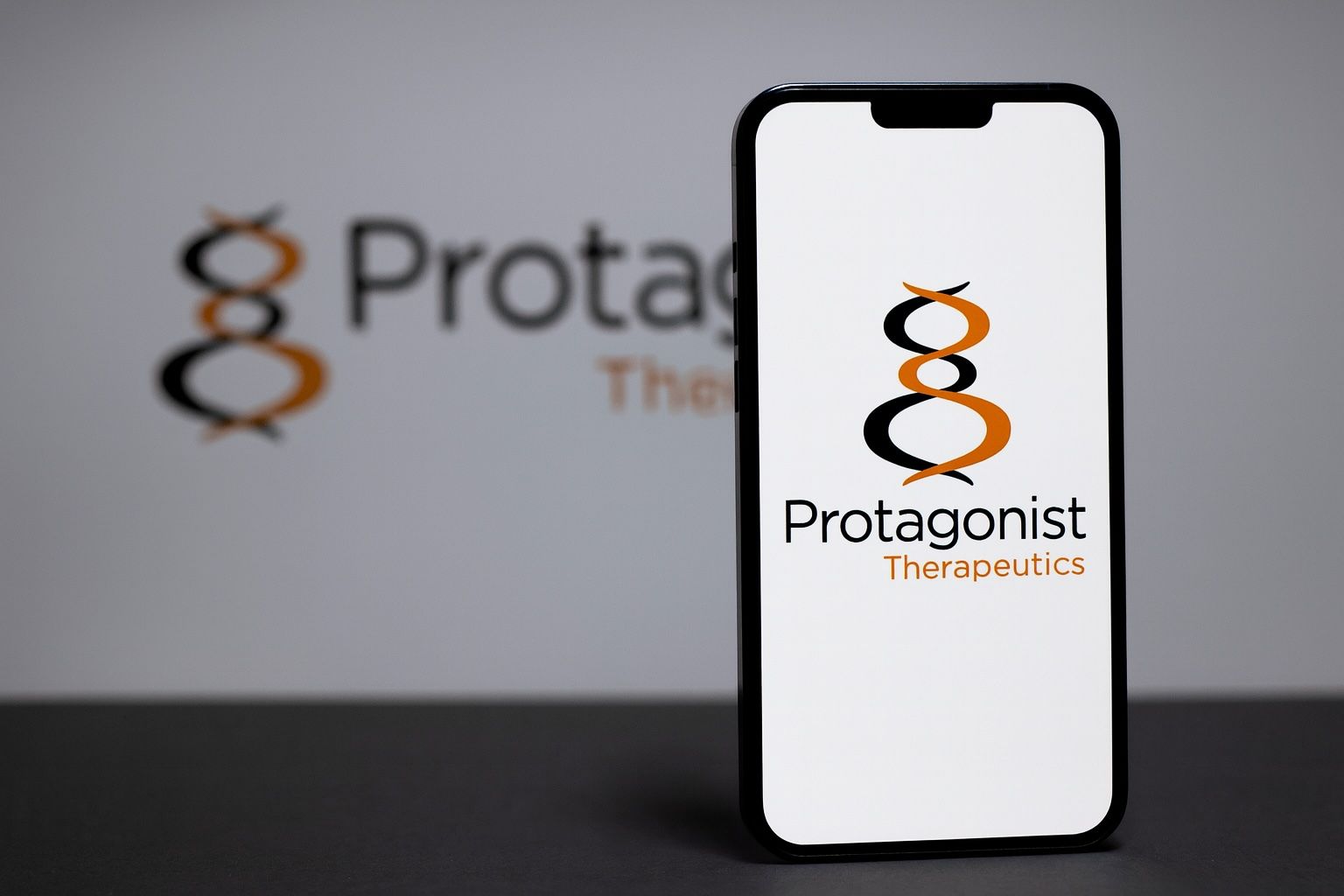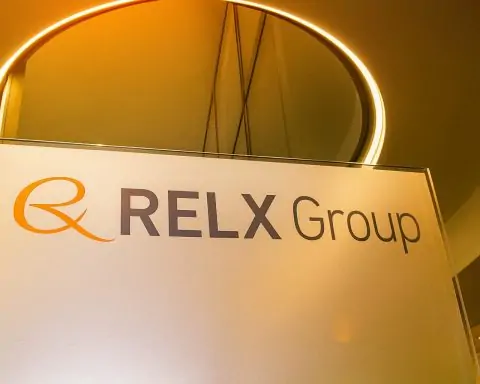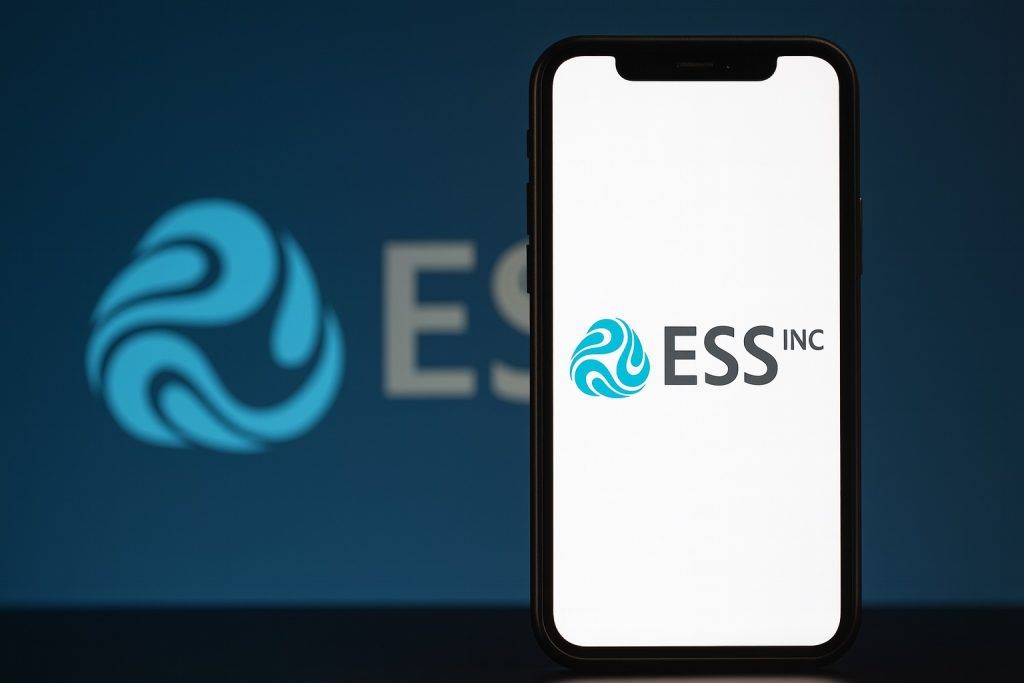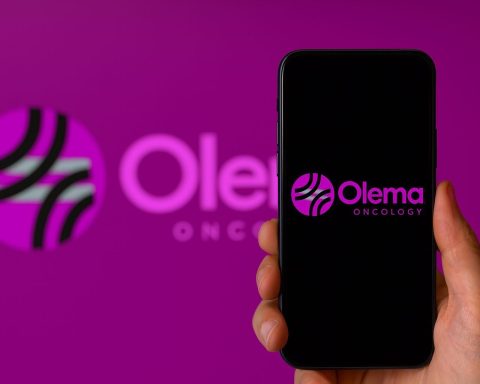- Latest Stock Price (Oct 10, 2025): $89.19 per share, after surging over 30% in a single day on reports that Johnson & Johnson (J&J) is in talks to acquire Protagonist Therapeutics [1] [2]. This jump pushed PTGX to a new 52-week high of $93.25, up from a previous close of $67.04 [3]. Trading was temporarily halted due to volatility following the news [4].
- Major Catalyst: J&J Acquisition Rumor. On Oct 10, 2025, The Wall Street Journal reported (confirmed by Reuters) that J&J is in discussions to buy Protagonist [5]. The potential deal would deepen J&J’s existing partnership with Protagonist on the oral IL-23 receptor antagonist Icotrokinra (JNJ-2113), a drug analysts say could be “one of the most impactful immunology drug launches of this decade,” with estimated peak sales of $9.5 billion [6].
- Recent Clinical Wins: Ulcerative Colitis & Psoriasis. Just days before the buyout buzz, J&J and Protagonist announced positive Phase 2b trial results for Icotrokinra in ulcerative colitis – the drug met its primary endpoint at all tested doses, showing significantly higher clinical response and remission rates versus placebo [7]. This follows a Phase 3 victory in plaque psoriasis (Nov 2024), where Icotrokinra (an oral peptide) achieved superior skin clearance relative to placebo, positioning it as a potential oral alternative to injectables and to Bristol Myers Squibb’s oral pill Sotyktu [8] [9].
- Pipeline & FDA Milestones: Protagonist’s second lead candidate Rusfertide (PTG-300) – a first-in-class hepcidin mimetic for polycythemia vera (a rare blood cancer) – delivered positive Phase 3 results (June 2025) by dramatically reducing the need for phlebotomy (blood removal) and improving blood cell counts [10] [11]. The FDA granted Breakthrough Therapy Designation to Rusfertide in August 2025, underscoring its potential to “transform disease management” in polycythemia vera [12]. Protagonist plans to file for FDA approval (NDA submission) for Rusfertide by end of 2025, aiming to bring this therapy to market in 2026 [13].
- Analyst Sentiment: Wall Street is bullish on PTGX. The stock carries a “Strong Buy” consensus rating, with 8–13 analysts covering it [14] [15]. Prior to the takeover news, the average 12-month price target was around $70–$75 per share [16] [17] – implying upside to earlier trading levels (and ~20% below the latest spike). Price targets range from about $57 on the low end to $80+ on the high end [18]. Notably, J&J already owns a small equity stake (~4%) in Protagonist via its collaboration, and no analysts currently recommend selling the stock [19] [20].
Recent News and Corporate Developments
J&J Buyout Buzz: The biggest news propelling Protagonist’s stock is the report that Johnson & Johnson is in talks to acquire Protagonist [21]. On October 10, 2025, The Wall Street Journal broke the story (later confirmed by Reuters) that J&J is negotiating a purchase of Protagonist Therapeutics [22]. This potential acquisition would build on the companies’ ongoing partnership: J&J’s Janssen unit has held exclusive worldwide rights to develop and commercialize Protagonist’s peptide drug Icotrokinra (JNJ-2113) since a 2017 collaboration deal [23]. In fact, J&J already holds rights to market Icotrokinra and reportedly owns a ~4% stake in Protagonist, reflecting its early confidence in the program [24].
According to Reuters, the discussions are driven by J&J’s strategic need to bolster its drug pipeline, especially in immunology [25]. J&J’s top-selling autoimmune drug Stelara is now facing cheap biosimilar competition, so the company is keen to fill that revenue gap [26]. Protagonist’s Icotrokinra could fit the bill: Leerink Partners analysts project this oral IL-23 receptor antagonist could achieve $9.5 billion in peak annual sales globally [27]. They describe it as potentially “one of the most impactful immunology drug launches of this decade” [28]. Acquiring Protagonist would allow J&J to fully own Icotrokinra’s future, rather than pay royalties – a strong incentive given the drug’s promise.
Protagonist’s management has so far declined to comment on the M&A rumors, calling them market speculation [29]. For its part, J&J also did not comment publicly on the talks [30]. It’s worth noting that no deal is final yet; however, investors are clearly optimistic that a takeover could materialize with a substantial premium. Any formal acquisition announcement by J&J would be a major development, potentially valuing Protagonist well above its recent $5+ billion market capitalization (after the rumor-fueled spike) [31] [32].
Positive Trial Results & FDA Updates: Aside from the buyout chatter, Protagonist has delivered a string of clinical and regulatory successes in recent months:
- Ulcerative Colitis Breakthrough (Oct 2025): On October 7, 2025, Johnson & Johnson and Protagonist announced that their oral IL-23 antagonist Icotrokinra achieved positive Phase 2b results in ulcerative colitis (UC) [33]. The mid-stage ANTHEM-UC study met its primary endpoint: all three dosing groups of once-daily Icotrokinra showed significantly higher clinical response rates at 12 weeks compared to placebo [34]. Patients on the highest dose had a 63.5% response vs just 27% on placebo, along with superior rates of clinical remission and endoscopic improvement [35] [36]. These results, presented at the UEG Week conference, underscore Icotrokinra’s potential as a first-in-class oral therapy for inflammatory bowel disease, complementing its efficacy already demonstrated in psoriasis. J&J signaled it will advance Icotrokinra into Phase 3 for ulcerative colitis, bolstered by the favorable efficacy and safety profile [37] [38].
- Psoriasis Pivotal Trials (Late 2024): Earlier, in November 2024, Phase 3 trial data in plaque psoriasis made headlines. In the ICONIC-LEAD and ICONIC-TOTAL studies, Icotrokinra (JNJ-2113) hit all co-primary endpoints, with 64.7% of treated patients achieving clear or almost clear skin by 16 weeks (versus ~8% on placebo) [39]. Nearly half of patients achieved 90% skin clearance (PASI 90), vastly outperforming placebo (~4%) [40]. By 24 weeks, response rates improved even further (over 74% achieving clear/almost clear skin) [41]. J&J heralded these outcomes as an “industry-leading combination of significant skin clearance with demonstrated tolerability” in a convenient once-daily pill [42]. This positions Icotrokinra as a strong competitor to existing psoriasis treatments – especially Bristol Myers Squibb’s Sotyktu (deucravacitinib), an oral pill approved in 2022. Analysts note Icotrokinra could challenge Sotyktu’s position by targeting the IL-23 pathway directly with an oral agent [43], potentially offering efficacy comparable to injectable biologics like Stelara or Skyrizi but in pill form.
- Polycythemia Vera Success & FDA Designation: Protagonist’s other flagship drug, Rusfertide (PTG-300) for polycythemia vera (PV), reached a pivotal milestone in mid-2025. In June 2025, at the ASCO conference, the company and partner Takeda presented full Phase 3 results from the VERIFY trial, which were resoundingly positive [44] [45]. Rusfertide, a weekly injected peptide that mimics the hormone hepcidin, met its primary endpoint by drastically reducing the need for phlebotomy (blood draws) in PV patients [46]. 76.9% of rusfertide-treated patients required no phlebotomy over 32 weeks, compared to only 32.9% in the placebo group (who continued standard care) [47]. All key secondary endpoints were also met with statistical significance [48] [49] – for example, rusfertide patients had a fourfold improvement in maintaining healthy hematocrit (red blood cell levels) and significantly better symptom control (less fatigue, etc.) than placebo [50] [51]. Importantly, no serious drug-related adverse events were seen, and safety was comparable to placebo [52] [53]. These impressive results led the FDA to grant Breakthrough Therapy Designation to Rusfertide in August 2025 [54], expediting its review. Protagonist’s CEO Dinesh Patel noted this designation “underscores [rusfertide’s] potential to demonstrate substantial improvement over available PV therapies”, which today rely on archaic phlebotomy and hydroxyurea [55]. The company is on track to file a New Drug Application (NDA) by end-of-year 2025 for rusfertide in polycythemia vera [56]. If approved (perhaps in 2026), rusfertide could become the first targeted therapy addressing PV by regulating iron and red blood cell production – essentially a “chemical phlebotomy” that spares patients from frequent bloodletting [57] [58].
- Other Developments: Protagonist’s pipeline progress has attracted industry partnerships. Beyond the J&J alliance, Takeda Pharmaceutical joined forces with Protagonist on rusfertide in a lucrative 2024 deal. Takeda paid $300 million upfront for co-development and co-commercialization rights to rusfertide [59], and Protagonist earned a $25 million milestone in Q1 2025 when rusfertide hit development goals [60]. This collaboration not only validates Protagonist’s science, but also provides significant financial support (milestones and a shared commercialization plan) as rusfertide approaches the market. Additionally, Protagonist in 2025 has been presenting earlier-stage research – for instance, nominating a new oral peptide drug candidate PN-477 for metabolic disease (obesity) and advancing PN-881, an IL-17 antagonist peptide, toward the clinic [61]. These preclinical programs, while still early, show the company’s broader ambition to leverage its proprietary peptide platform beyond the current late-stage drugs.
In summary, Protagonist Therapeutics enters Q4 2025 with significant momentum on multiple fronts. The J&J takeover rumor caps a year of clinical triumphs and partnership wins. Whether or not an acquisition transpires, Protagonist has firmly transitioned from a development-stage biotech into a company on the cusp of commercialization, with two potential first-in-class medicines (for psoriasis/IBD and for polycythemia vera) nearing the finish line.
Stock Performance: Price Trends, Volume & Volatility
Soaring to New Highs: Protagonist’s stock (NASDAQ: PTGX) has been a standout performer in 2025, and the J&J news sent it into overdrive. On October 10, 2025, PTGX exploded upward by 30–34% intraday, reaching an all-time high around the mid-$90s [62]. It closed near $89 per share that day [63], roughly tripling from its 52-week low of $33.31 earlier in the year [64]. This one-day leap continued a strong upward trend: year-to-date, the stock had already gained over 70% even before the latest jump [65] [66], fueled by clinical successes and bullish sentiment. The current price levels imply a market capitalization around $5.5–5.6 billion [67] – a remarkable climb for a company that was valued near $1.5–2 billion just a year ago.
Volume Spike and Volatility: Trading activity in PTGX has been intense during news events. The average daily volume for the stock is about 0.85 million shares [68], but on big news days, volume has swelled to several times that number as investors rush in. In fact, when the WSJ report of J&J’s interest hit on Oct 10, trading was so frenzied that NASDAQ temporarily halted PTGX due to the rapid price spike [69]. Once trading resumed, the stock continued climbing, ultimately gaining about one-third in value on that day. Such volatility is not unusual for clinical-stage biotech stocks, especially when subject to takeover speculation or binary drug trial outcomes. Protagonist’s 52-week trading range (from ~$33 to $93) illustrates this volatility [70]. The stock’s 5-year beta is around 2.2, meaning it has been more than twice as volatile as the overall market on average [71]. This elevated volatility reflects both the high risk-reward nature of biotech R&D and the sharp re-rating of Protagonist’s prospects as key milestones were hit.
Over the past 12 months, PTGX’s chart shows several notable surges corresponding to news releases. For instance, shares jumped in late 2024 when the positive psoriasis Phase 3 data emerged, again in mid-2025 on rusfertide’s Phase 3 success and FDA designations, and most recently on the October 2025 buyout rumors. Each time, the stock reached new highs, demonstrating strong momentum. Technical indicators have been bullish: even before the latest jump, PTGX was trading above its 50-day and 200-day moving averages ($57.65 and $48.31 respectively as of late September) [72], and its RSI (relative strength index) was in the low 60s – indicating positive momentum without extreme overbought conditions [73]. This technical strength provided a solid base that likely amplified the reaction to new fundamentals.
Pullbacks and Risks: Despite the strong uptrend, investors should note that biotech stocks can pull back quickly on any negative surprises. While Protagonist has mostly delivered good news lately, risks remain (e.g. regulatory delays, safety issues that could emerge in larger trials, or deal negotiations falling through). The stock did experience some choppiness – for example, mild profit-taking dips – after its mid-year run-ups. However, those dips were shallow, and dip-buyers stepped in, reflecting confidence in the company’s long-term story. With the stock now at highs and pricing in a substantial takeover premium, volatility may stay elevated. Any definitive word on an acquisition (or lack thereof) could move the stock dramatically in either direction. Furthermore, as a development-stage biotech, Protagonist’s valuation is heavily tied to expectations for future drug sales, which introduces risk if those expectations change.
Overall, Protagonist’s stock performance has been exceptionally strong, driven by tangible clinical achievements and the excitement of a potential Big Pharma buyout. The combination of real drug development progress and M&A speculation has created a “perfect storm” of bullish catalysts in 2025. Investors holding from earlier in the year have seen tremendous paper gains, while new investors are now evaluating if more upside exists (via a buyout above current prices) or if the rally has overshot near-term fundamentals. This sets the stage for analysts’ and experts’ views on what comes next for PTGX.
Expert Commentary and Analyst Forecasts
Wall Street’s View – Largely Optimistic: Sell-side analysts have, for the most part, been extremely positive on Protagonist Therapeutics. According to multiple analyst surveys, PTGX is rated a “Strong Buy” on consensus, with virtually all covering analysts recommending Buy and only a rare Hold, and zero Sell ratings [74] [75]. As of early October 2025, 8 to 13 analysts (depending on the source) cover the stock – a relatively high number for a mid-cap biotech, indicating substantial interest. DirectorsTalk noted 12 Buy ratings and 1 Hold in late September [76], while StockAnalysis tallied 8 analysts at Strong Buy consensus [77]; in either case, the sentiment is clearly bullish across the board.
Price Targets: The average 12-month price target for PTGX before the J&J news was roughly $70–$75 per share [78] [79]. For instance, StockAnalysis reported an average target of $71.13 (range $57 to $80) among 8 analysts [80], and Benzinga found an average of $74.8 (high $80, low $69) from 5 recent analyst updates [81]. These targets generally implied a high-single-digit percentage upside from the mid-$60s trading range that PTGX had in late Q3 2025 [82] [83]. However, with the stock’s surge into the high $80s-$90s, current trading is above most analysts’ targets – a situation likely to prompt target upgrades if those analysts believe the J&J buyout will occur or that Protagonist’s standalone value has increased. Indeed, some analysts have already been adjusting their models upward through 2025: for example, JMP Securities raised its target from $67 to $69 in August after earnings [84], and multiple firms initiated coverage in September around the $72–$73 level (Barclays at $72, Leerink at $73) with bullish ratings [85] [86]. H.C. Wainwright’s analyst reiterated a Street-high $80 target for PTGX as recently as October 8, 2025 [87] [88], citing the robust pipeline progress.
It’s worth noting that analysts’ valuation of Protagonist is heavily contingent on the success of Icotrokinra and Rusfertide. The price targets in the $70–$80 range were set assuming Protagonist remains independent and continues to develop/launch these drugs (often using risk-adjusted sales forecasts). A potential J&J acquisition introduces the possibility of a higher one-time buyout price. Some market commentators speculated that a deal, if struck, could “well surpass” Protagonist’s pre-rumor market cap of ~$4 billion [89]. For example, if J&J values the future cash flows of Icotrokinra at a premium (given the $9.5B peak sales estimate [90]), a takeover price could theoretically be in the high-single-digit billions. This optionality may explain why PTGX stock now trades above the consensus target – investors are effectively betting on a takeout premium.
Quotes from Experts: Many analysts and biotech experts have lauded Protagonist’s scientific approach and the strategic rationale for a partnership or acquisition. Leerink Partners (SVB Securities) analysts, as mentioned, were especially bullish on Icotrokinra, calling it potentially “one of the most impactful immunology drug launches of this decade” [91]. They argue that an oral IL-23 pathway inhibitor could capture significant market share in diseases like psoriasis and ulcerative colitis, given the convenience advantage over injectable biologics and the potency demonstrated in trials. If peak sales indeed approach ~$10 billion globally, this single asset could justify a multi-billion dollar valuation for Protagonist, even before considering rusfertide.
On the rusfertide front, hematology experts are also upbeat. FDA Breakthrough designation is a strong signal; as Protagonist’s CEO Dinesh Patel put it, “we are very pleased with the FDA’s decision…which underscores [rusfertide’s] potential to demonstrate substantial improvement over available PV therapies” [92]. Dr. Patel has emphasized that rusfertide’s Phase 3 data “validate more than a decade of scientific innovation” from Protagonist’s peptide platform and that the drug could “potentially transform the standard of care” for PV in partnership with Takeda [93] [94]. Analysts note that Takeda’s involvement (and hefty upfront payment) de-risks rusfertide’s development both financially and operationally, increasing confidence that the drug will reach the market successfully.
Some independent commentators have offered cautionary notes – for instance, that Protagonist’s stock, after its huge rally, may be pricing in perfection. There was a recent reaffirmation of a “Sell (D+)” quant rating on PTGX by one research service (citing valuation concerns) [95], but this appears to be an outlier view. More common is the sentiment expressed on investment platforms like TipRanks, where top analysts remain bullish and even raised forecasts after the UC trial news, highlighting the “therapeutic potential” of Icotrokinra and Protagonist’s strong year-to-date performance [96].
Analyst Forecasts – The Numbers: Looking ahead, analysts expect Protagonist’s financials to shift dramatically if its drugs are approved. As a baseline, consensus forecasts (preliminary) show revenue jumping from about $47 million in 2025 (mostly milestone/license revenue) to over $160 million in 2026, as product sales potentially kick in [97]. By 2027–2028, sales could climb into the hundreds of millions if rusfertide launches in PV and J&J launches Icotrokinra in psoriasis/IBD (with royalties flowing to Protagonist, unless it’s acquired by then). Earnings per share are projected to remain negative in 2025 (-$2.04) but improve to around -$1.03 in 2026 as revenues ramp up and costs stabilize [98]. Profitability is not expected until beyond 2026 in most models, given continued R&D and the fact that Protagonist would likely pay for a share of rusfertide commercialization expenses (and might not consolidate J&J’s sales of Icotrokinra). Nonetheless, the long-term outlook painted by analysts is clearly favorable – they see Protagonist as a future commercial-stage biotech with growing sales, rather than a perpetual R&D outfit.
In summary, expert commentary on Protagonist Therapeutics is largely positive. The combination of a cutting-edge technology platform, two late-stage drug successes, and validation from heavyweights like J&J and Takeda has earned PTGX enthusiastic endorsements from analysts. The key questions experts are watching now: Will J&J pull the trigger on an acquisition? And if not, can Protagonist successfully transition to a standalone commercial company? The consensus seems to be that, one way or another, Protagonist’s innovations put it on a path to significantly higher intrinsic value than it had just a year or two ago – which bodes well for investors, barring unforeseen setbacks.
Competitive Positioning in Biotech
Protagonist Therapeutics operates at the intersection of immunology and hematology, with a unique focus on peptide-based drugs. It faces competition on several fronts, yet the company has carved out a strong competitive position by targeting unmet needs with novel treatment modalities:
- In Immunology (Psoriasis & IBD): Protagonist’s Icotrokinra (JNJ-2113) is on track to become the first oral peptide drug targeting the IL-23 pathway. In moderate-to-severe plaque psoriasis, the current standard of care for high efficacy is biologic injectables (like J&J’s own Stelara and Tremfya, or AbbVie’s Skyrizi, which target IL-23/IL-12 or IL-23). The only approved oral therapies for severe psoriasis are systemic small molecules like methotrexate, apremilast (Otezla), or the newer deucravacitinib (Sotyktu) from Bristol Myers Squibb. Sotyktu, approved in 2022, has gained traction as a convenient oral option, but it inhibits TYK2 (a different mechanism) and its efficacy, while good, is a notch below the best injectables. This is where Icotrokinra could shine – it directly blocks the IL-23 receptor via a peptide, aiming to match biologic-like efficacy in a pill [99] [100]. If it succeeds, it could poach patients from both the injectable biologics (by offering similar results without injections) and from Sotyktu (by possibly delivering greater skin clearance).In ulcerative colitis and Crohn’s disease (inflammatory bowel diseases), the competitive landscape also features injectable biologics (e.g. anti-TNF drugs, anti-IL-12/23 like Stelara, anti-integrins, etc.) and newer oral small molecules (like tofacitinib or ozanimod). An oral IL-23R antagonist could be a game-changer here as well. With the ANTHEM-UC Phase 2b success, Icotrokinra is now advancing to Phase 3 in UC [101], aiming to become a first-in-class oral option for these patients. The competitive edge of Icotrokinra is its unique modality: as a constrained peptide, it can disrupt protein-protein interactions (like IL-23 binding its receptor) similar to antibodies, but is small enough to be orally bioavailable – something traditional large-molecule biologics cannot achieve. Protagonist’s proprietary platform enables this novel chemistry [102]. This gives the company a leg up in a field where few others have oral biologic-mimetic drugs. If approved, J&J (assuming it retains rights) would likely position Icotrokinra as a rival to injectable IL-23 drugs and a superior alternative to some oral therapies. Bristol Myers Squibb’s Sotyktu would be the most direct competitor on the oral side; interestingly, analysts have already started comparing trial data, and there’s a sense that Icotrokinra’s efficacy might “pad its case” in head-to-head comparisons [103]. In summary, competitively Icotrokinra could occupy a unique high-efficacy oral segment, which might allow it to capture significant market share from both legacy biologics and less efficacious pills.
- In Hematology (Polycythemia Vera): Polycythemia vera (PV) is a rare chronic blood cancer where the bone marrow overproduces red blood cells, leading to thickened blood and risk of clots. The standard treatment has long been phlebotomy (periodic blood draws to reduce hematocrit) along with medications like hydroxyurea or interferon to slow blood cell production. Pharma competition in PV has been relatively sparse. Recently, ropeginterferon alfa (Besremi) was approved (late 2021) for PV, giving patients a new injectable option that can induce hematologic responses. Aside from that, Janus kinase (JAK) inhibitors like ruxolitinib (Jakafi) are used off-label in some cases. Rusfertide’s competitive positioning looks quite strong in this niche: it introduces a novel mechanism (hepcidin mimetic) that specifically addresses the core problem of PV – excess iron and red cell production – effectively acting as a pharmacological alternative to phlebotomy [104]. The Phase 3 data showed rusfertide can maintain hematocrit control without phlebotomy in ~77% of patients, which is a remarkable improvement over existing care [105]. No current therapy, not even interferon, achieves that degree of phlebotomy independence. Additionally, rusfertide improved symptoms like fatigue (as measured by patient-reported outcomes), which is a differentiator since phlebotomy and existing drugs often don’t fully address symptom burden [106] [107]. Given its Breakthrough designation and pending FDA filing, rusfertide could potentially be first-to-market in a new class of PV treatments.One competitive consideration: Protagonist is co-developing rusfertide with Takeda, which means Takeda’s oncology sales force will likely help launch and market rusfertide globally. This is a boon for competitiveness because Takeda brings resources and reach in hematology that Protagonist alone wouldn’t have. It also suggests that rusfertide will be priced and positioned as a high-value therapy (much like other breakthrough orphan disease drugs). The PV patient population is modest in size (in the low hundreds of thousands worldwide), so market share will depend on convincing hematologists to use rusfertide early in the treatment course. The robust data and ease of use (weekly self-injection) give it an edge to become standard-of-care for high-risk PV alongside or in place of older drugs. The main competitors rusfertide will face are likely Besremi (interferon) and potentially any future JAK2 inhibitors or other novel agents in development (for example, momelotinib was explored in PV, and there are a few early-stage programs). However, at this stage, no competitor matches rusfertide’s combination of efficacy and tolerability demonstrated in a Phase 3 trial. Analysts thus see rusfertide as a likely “best-in-class” for PV if approved [108] [109].
- Peptide Therapeutics vs. Traditional Biotech: On a broader industry level, Protagonist’s focus on engineered peptides sets it somewhat apart from many peers. While numerous biotech companies work on small molecules or antibodies, few have successfully developed orally stable peptides that can hit intracellular or traditionally “undruggable” targets. This gives Protagonist a kind of technological moat in certain areas. One could compare Protagonist to other peptide-platform companies (like PeptiDream in Japan or Bicycle Therapeutics in the UK), but Protagonist is ahead in having late-stage clinical assets. In terms of therapeutic area peers, Protagonist’s competitors are often much larger pharma companies (as described above for psoriasis and PV). This could have been a disadvantage if Protagonist tried to commercialize alone, but by partnering smartly (J&J, Takeda) or via a buyout, the company ensures it can go head-to-head with big players.
Additionally, the M&A interest from J&J is itself a competitive outcome – it indicates that a top-tier pharma sees Protagonist’s pipeline as valuable enough to potentially acquire rather than compete against. Should J&J indeed acquire Protagonist, the competitive landscape shifts: Icotrokinra would then be backed by J&J’s might, virtually guaranteeing strong competition for BMS and others, while removing Protagonist as an independent competitor in the biotech space. If no acquisition occurs, Protagonist will rely on its partnerships and its strong cash position to compete and bring products to market. The company had ~$673 million in cash as of mid-2025 [110], enough to fund operations through pivotal trials and initial commercialization, which is a competitive advantage over many cash-strapped biotechs that depend on continual fundraising. This war chest means Protagonist can negotiate from a position of strength, whether competing or collaborating.
In summary, Protagonist is well-positioned against its competition by targeting areas with high unmet need and limited existing options (PV), or by providing a differentiated solution in crowded markets (an oral IL-23 for psoriasis/IBD). Backed by strong partners and ample capital, Protagonist’s therapies have a realistic path to carving out significant market share. Of course, the ultimate competitive success will hinge on execution: gaining regulatory approvals, educating physicians, and demonstrating real-world benefits. But based on trial results to date, Protagonist’s lead drugs have the profile needed to compete effectively and possibly dominate their niches.
Financial Performance and Key Metrics
As a clinical-stage biotech, Protagonist Therapeutics is not yet generating product revenues from drug sales, but its financial position is relatively strong thanks to collaboration deals. The company’s finances reflect the typical profile of a late-stage biotech: modest license revenue, substantial R&D investment, and operating losses – offset by a large cash reserve from partner funding.
Recent Earnings: In the latest reported quarter (Q2 2025), Protagonist posted license and collaboration revenue of $5.5 million [111] [112]. This revenue came primarily from the ongoing partnership with Takeda for rusfertide, including recognition of payments for R&D services. Notably, the $5.5M in Q2 2025 was a 33% increase over Q2 2024’s $4.2M, indicating higher reimbursed activity or milestone contributions [113]. For the first half of 2025, total collaboration revenue was $33.9 million [114]. However, this figure is dwarfed by the prior year: in H1 2024, Protagonist recognized a one-time $259.1 million revenue windfall, largely due to the $300 million upfront payment from Takeda when the rusfertide deal was signed [115]. That 2024 upfront inflates any year-over-year comparisons – for example, Protagonist actually showed a net profit in 2024 because of that huge payment (FY2024 EPS was positive). But excluding such one-offs, the company’s core operations remain in loss-making mode, as expected for a company funding multiple Phase 3 trials.
In Q2 2025, net loss was $34.8 million (–$0.55 per share) [116]. Operating expenses consisted of $37.0M in R&D and $10.6M in G&A for the quarter [117], both growing modestly (~10%) from the prior year as trials progressed [118]. This burn rate is actually quite reasonable given Protagonist’s stage – the company is spending to push two lead programs through late-stage development simultaneously. For the first six months of 2025, the net loss totaled $46.4M [119] [120], again reflecting heavy R&D outlays. It’s worth noting the company also earns significant interest income on its cash (over $7M in Q2 2025) thanks to higher interest rates [121], which offsets some expenses.
Cash and Balance Sheet: Protagonist’s balance sheet is a highlight. As of June 30, 2025, the company reported $673.0 million in cash, cash equivalents, and marketable securities [122]. This war chest is a result of the 2024 Takeda upfront payment ($300M), prior licensing fees from J&J, and secondary stock offerings (the company raised equity when its share price climbed in late 2024, shoring up capital). The cash on hand is projected to fund operations through 2027 or 2028 based on current burn rates [123]. In other words, Protagonist does not need to raise new capital in the immediate future, which is a significant de-risking factor for investors. Many biotechs at this stage have to dilute shareholders regularly to raise cash, but Protagonist’s partnerships effectively pre-funded much of its development costs.
The company’s balance sheet is otherwise clean – debt is minimal (debt-to-equity ratio was only 0.02 as per one analysis [124]). Protagonist’s equity base has grown with its fundraising; as of mid-2025 there were about 63.5 million shares outstanding [125] (up from ~61 million the year prior, reflecting a small dilution). This relatively low share count means that any future profits (or a buyout price) won’t be spread too thinly.
Profitability Metrics: Traditional valuation metrics like P/E or PEG ratios are not very meaningful for Protagonist at this stage. Interestingly, due to the one-time license revenue in 2024, the trailing twelve-month EPS by mid-2025 was +$0.70 [126], giving a transient P/E ratio in the 90s [127]. But going forward, the company is expected to return to negative earnings until product launches occur. Instead, investors focus on cash burn vs. cash reserves and the potential future earnings from drug sales. In that regard, Protagonist’s financial health is solid: with a current ratio above 16 and effectively no debt, liquidity is very high [128]. GuruFocus noted Protagonist has an Altman Z-Score of 50.98, signaling no financial distress [129]. The main financial risk flagged was a high Beneish M-Score (suggesting the need to monitor accounting, likely due to the large revenue recognition from the Takeda deal) [130], but there is no indication of any actual issues on that front – it’s likely just an artifact of the unusual revenue swing.
Cash Burn and Runway: As mentioned, Protagonist’s operating cash burn is on the order of ~$30–35M per quarter in 2025. Annualizing that, ~$120–140M per year, the $673M cash pile provides nearly 5 years of runway at the current burn – indeed, management has indicated they have funding secured through the anticipated NDA approvals and even initial launches. This is a comforting metric for investors because it means Protagonist can reach value-inflection points (FDA approvals, commercialization) without needing to tap markets for more cash. It also strengthens Protagonist’s negotiating hand in any partnership or buyout discussions, as the company is not under financial pressure to take a low offer.
Financial Outlook: If one of Protagonist’s drugs gets approved, the financial picture will shift from pure expenses to revenue-generating. For example, if rusfertide launches in 2026 (co-commercialized with Takeda), Protagonist could start seeing product revenue and royalties. J&J’s commercialization of Icotrokinra (if approved for psoriasis by ~2026) would yield Protagonist milestone payments and mid-single-digit to low-double-digit royalties (exact terms not publicly disclosed, but typical for such deals). Thus, analysts project major revenue growth in 2026–2027. One estimate shows revenue jumping to ~$162.5M in 2026 (from ~$47M in 2025) [131], and further climbing thereafter. Profitability might follow a couple of years later as sales ramp up. However, all these projections could be rendered moot if J&J acquires Protagonist – in that scenario, PTGX shareholders would likely receive a one-time cash (or stock) payment rather than ride the multi-year earnings trajectory.
In the meantime, Protagonist’s management continues to invest in R&D. They have mentioned expanding their pipeline (with new preclinical candidates like PN-943 for IBD and others) [132], which will consume some resources but is aimed at ensuring long-term growth beyond the current two lead programs. The company’s operational efficiency has been fairly good – R&D spend is focused and hasn’t ballooned uncontrollably, and G&A is kept relatively low (around $10M/quarter) indicating a lean organization.
To sum up, Protagonist’s financial profile is one of a well-funded late-stage biotech: losses are expected in the near term, but the cash runway and partnership inflows put it in a stable position. Key metrics to watch will be how quickly expenses rise as the company potentially prepares for product launches (e.g., building a commercial team if needed) and any additional milestones from partners. For investors, the lack of near-term dilution risk and the strong balance sheet are big pluses, giving Protagonist the freedom to either go-it-alone or await a buyout from a position of strength.
Pipeline Overview and Scientific Outlook
Protagonist Therapeutics has built a robust pipeline centered on its proprietary peptide technology platform, which allows the design of “constrained peptides” – molecules that combine the target specificity of large biologic drugs with the oral availability of small molecules [133]. This platform underpins the company’s current clinical candidates and its future drug discovery efforts. Here’s an overview of the pipeline and what’s next:
- Icotrokinra (JNJ-2113) – Oral IL-23 Receptor Antagonist for Autoimmune Diseases: This is Protagonist’s most advanced asset, jointly developed with Janssen (J&J’s pharma division). Scientifically, Icotrokinra (also referred to by Janssen as JNJ-2113) is a first-in-class oral peptide that binds to the IL-23 receptor and blocks IL-23 signaling [134]. IL-23 is a key cytokine driving inflammation in diseases like psoriasis, psoriatic arthritis, and inflammatory bowel disease. Traditionally, IL-23 is targeted by injectable monoclonal antibodies; Icotrokinra offers a novel oral approach. The drug has completed Phase 3 trials in plaque psoriasis with excellent results (as detailed earlier) [135] [136]. Janssen is expected to file for regulatory approval in psoriasis once they have complete data (possibly in 2025 or early 2026). Additionally, with positive Phase 2b data in ulcerative colitis, Icotrokinra is heading into Phase 3 for UC and likely will be tested in Crohn’s disease as well [137] [138]. The breadth of its potential uses (psoriasis, UC, possibly psoriatic arthritis and Crohn’s) means it could become a franchise drug in immunology if all goes well. From a scientific standpoint, Icotrokinra validates Protagonist’s platform – it was “jointly discovered” by Protagonist and Janssen scientists and emerged from a 2017 collaboration that could earn Protagonist up to ~$1 billion in milestones [139] [140]. The journey from de novo discovery to Phase 3 was rapid (~8 years), showcasing the platform’s efficiency [141]. Outlook: Bright. If approved, Icotrokinra would likely be marketed by J&J (with Protagonist receiving royalties). Its prospects are strong, given superior trial data and J&J’s commitment. The main scientific questions remaining are long-term safety (as with any new immunomodulator) and how it will stack up in head-to-head comparisons, but so far its profile looks very compelling.
- Rusfertide (PTG-300) – Injected Hepcidin Mimetic for Polycythemia Vera: Rusfertide is a peptide analogue of the natural hormone hepcidin, which regulates iron metabolism. By mimicking hepcidin, rusfertide essentially “starves” the bone marrow of iron, thereby reducing excessive red blood cell production – an innovative strategy to control polycythemia vera. Scientifically, this approach is elegant: it addresses the root cause of PV (erythrocytosis) without directly suppressing the bone marrow via chemotherapy (like hydroxyurea does). After very encouraging Phase 2 results, rusfertide’s Phase 3 VERIFY trial confirmed its efficacy and safety [142] [143]. The fact that it achieved all primary and secondary endpoints and improved patient symptoms is a strong testament to its therapeutic potential [144] [145]. Rusfertide has Orphan Drug and Fast Track status in the U.S., and now Breakthrough Therapy Designation as well [146] [147] – the latter indicating the FDA sees it as potentially a substantial improvement over existing PV treatments. Protagonist, in partnership with Takeda, is preparing to file for FDA approval by end of 2025 [148], and likely will file in Europe and other regions thereafter. Outlook: Very promising. If approved, rusfertide could become the new standard for PV, transforming patient care. Its scientific impact might extend beyond PV too – theoretically, any condition of iron dysregulation or overproduction of blood cells (like some other myeloproliferative neoplasms) could be future targets. Protagonist has hinted at exploring rusfertide in related indications or in patients who have high hematocrit for other reasons. In terms of lifecycle, a lot will depend on real-world use in PV and whether any rare side effects emerge with longer use (prior small studies raised a minor concern about temporary injection site reactions and mild anemia, but no major issues so far [149]). With Takeda’s backing, rusfertide’s development and commercialization are in experienced hands.
- Emerging Pipeline Candidates: Protagonist isn’t stopping at two drugs. The company is leveraging its peptide platform to generate a next wave of candidates:
- PN-943: This was an orally delivered peptide antagonist of α4β7 integrin, aimed at inflammatory bowel disease (a mechanism similar to the antibody vedolizumab/Entyvio). PN-943 was in Phase 2 for ulcerative colitis; however, in 2022 the results were mixed and the program’s status became uncertain. It’s been somewhat superseded by Icotrokinra for IBD. It’s unclear if Protagonist will further pursue PN-943 or focus on the more potent assets – likely the latter, as PN-943 was not prominently mentioned in 2025 updates except a brief note in an investor outlook [150].
- PN-235 / PN-232: These were earlier IL-23 pathway peptides from the J&J collaboration (with PN-235 being another name for Icotrokinra in some older literature). Essentially, JNJ-2113 is the lead from that collaboration.
- PN-477: A newly nominated candidate, described as an “oral and injectable triple-agonist peptide” for obesity and metabolic disease [151] [152]. This likely targets three gut hormone receptors (possibly GLP-1, GIP, and glucagon receptors, a popular trio for weight loss therapies). This is still preclinical, but notably, it shows Protagonist expanding into the metabolic disorders space, which is a hot area due to the success of drugs like semaglutide. A peptide that can act as a triple agonist could be very valuable if it reaches clinical proof-of-concept, but it’s early.
- PN-881: An oral IL-17 antagonist peptide [153]. IL-17 is another key cytokine in autoimmune diseases (targeted by drugs like secukinumab/Cosentyx). An oral IL-17 blocker could complement the IL-23 oral (Icotrokinra) and position Protagonist as a leader in oral peptide therapies for multiple inflammatory pathways. PN-881 is preclinical, with presumably IND-enabling studies ongoing in 2025.
- Oral Hepcidin Mimetic Program: Beyond rusfertide (which is injectable), Protagonist has mentioned working on orally bioavailable hepcidin mimetics [154]. If they can create a pill that mimics hepcidin, it could have uses in diseases of iron overload or even anemia of chronic disease. This speaks to the platform’s versatility – turning peptide hormones that usually are injectable into oral drugs.
From a scientific outlook perspective, Protagonist’s success with Icotrokinra and rusfertide provides proof that their discovery platform works and can produce clinical winners. Going forward, the company will likely continue to exploit difficult targets where neither small molecules nor classic antibodies are ideal, but where a constrained peptide can hit the sweet spot. This strategy positions Protagonist in a somewhat blue ocean of drug discovery, with fewer direct competitors using the same modality.
R&D and Innovation: The company’s R&D is led by experienced scientists (their Chief Scientific Officer and team have peptide expertise). The collaboration model has served them well – by partnering early with big pharma for certain programs, Protagonist has been able to accelerate development and reduce risk (as seen with J&J for IL-23 and Takeda for PV). For newer programs like PN-477 or PN-881, Protagonist might initially develop them in-house through Phase 1/2 and then consider partnerships if needed, or possibly take some to market alone in specialized fields.
The scientific community has taken note of Protagonist’s work. The fact that multiple presentations at top conferences(ASCO, UEG Week, dermatology meetings, etc.) featured their data in 2024-2025 speaks to the importance of these findings. Outside experts, such as Dr. Andrew Kuykendall at Moffitt Cancer Center who led the VERIFY PV trial, have commented that rusfertide’s results “suggest rusfertide has the potential to become part of the standard of care in PV” [155] [156]. Similarly, in psoriasis, having an oral agent that performs so well is generating buzz among dermatologists.
Challenges and Next Steps: The pipeline’s future success will depend on navigating regulatory hurdles. For Icotrokinra, an NDA filing in psoriasis could come in 2025. One open question: will the FDA require any additional safety data or trials given it’s a novel modality? The Phase 3 program was comprehensive, so likely not, but monitoring for rare events (e.g. infections, given IL-23 suppression) will be key. For rusfertide, as a novel therapy for PV, the FDA will scrutinize long-term safety, especially any signals of liver effects or malignancies (so far none directly attributed to the drug, and indeed cancer rates were lower on rusfertide than placebo in the trial [157], which is reassuring). Protagonist and Takeda plan to establish a robust safety monitoring program as part of post-marketing, which is standard for a BTD drug in a chronic condition.
Finally, if Protagonist remains independent, by 2026-2027 it could transform into a commercial-stage company, marketing rusfertide (co-promote with Takeda) and possibly receiving royalties from J&J’s sales of Icotrokinra. This transition from pure R&D to commercial will be a critical period – many biotechs stumble in commercialization. However, Protagonist’s partnership approach means it will not be doing this alone; Takeda will handle a lot of PV commercialization, and J&J entirely handles IBD/psoriasis commercialization. This allows Protagonist to focus on what it does best: innovative drug discovery and development.
In conclusion, the pipeline outlook for Protagonist is exceptionally strong for a company of its size. Two near-term product opportunities could significantly improve patients’ lives and generate substantial revenue. Meanwhile, the scientific engine behind those drugs is spinning off new candidates that could address other large markets (like obesity or additional autoimmune diseases). If even one of those early-stage programs hits its mark, Protagonist could have a thirdact in the coming years. Investors and scientists alike will be watching how effectively the company can repeat its past success – but given the validation so far, there’s reason to be confident in Protagonist’s R&D approach.
Bottom Line: Protagonist Therapeutics has rapidly evolved into one of the year’s most compelling biotech stories. The stock’s dramatic rise – capped by acquisition rumors – reflects tangible progress in bringing two innovative drugs to market. Recent news flow has been overwhelmingly positive: major clinical victories in psoriasis, ulcerative colitis, and polycythemia vera, regulatory blessings like Breakthrough status, and the vote of confidence from blue-chip partners (and potential acquirer) Johnson & Johnson and Takeda. While risks inherent to biotech remain, Protagonist’s trajectory suggests a company on the verge of delivering real medical breakthroughs. For investors interested in biotech, PTGX offers a mix of near-term catalysts (FDA approvals, possible buyout) and long-term value via its rich pipeline and platform. It’s a high-reward story that has so far justified the market’s enthusiasm, making Protagonist Therapeutics a stock to watch closely as the next chapters – regulatory decisions, potential M&A, and commercial rollout – unfold.
Sources:
- Reuters – Johnson & Johnson in talks to acquire Protagonist Therapeutics [158] [159] [160] [161]
- GuruFocus – PTGX Stock Surges Over 34% (market move, financial metrics) [162] [163]
- Investing.com – Real-time PTGX quote and stats (price, range, market cap) [164] [165]
- TipRanks News – PTGX Stock Surges on Drug Success (analyst outlook after UC data) [166] [167]
- FierceBiotech – J&J oral psoriasis prospect passes Phase 3 (psoriasis trial results) [168] [169]
- J&J Press Release via PR Newswire – Icotrokinra data in ulcerative colitis (ANTHEM-UC) [170]
- Pharmacy Times – Rusfertide Gains Breakthrough Therapy Designation (FDA BTD, CEO quote, NDA timing) [171] [172]
- ASCO 2025 Presentation (Takeda/Protagonist) – VERIFY Phase 3 Rusfertide results in PV [173] [174]
- DirectorsTalk – PTGX Investor Outlook (Sep 30, 2025) (analyst ratings, technicals, pipeline summary) [175] [176]
- Benzinga – 5 Analysts Assess Protagonist Therapeutics (average price target, recent ratings) [177] [178]
- StockAnalysis – Analyst Forecast & Ratings for PTGX [179] [180]
- Reuters – Leerink quote on Icotrokinra peak sales [181]
- Reuters – Context on J&J strategy and Stelara biosimilars [182]
- Reuters – Protagonist’s Takeda collaboration (rusfertide co-development) [183]
- StockTitan (Press Release) – Protagonist Q2 2025 Results (revenue, net loss, cash) [184] [185]
- MarketBeat/TipRanks data – Market cap, P/E, beta for PTGX [186] [187]
- Yahoo Finance/Dow Jones – Trading halt and price spike on WSJ report [188]
- Protagonist Inc. – Pipeline and collaboration details [189] [190]
- CEO and CMO quotes (Protagonist PR & Pharmacy Times) on rusfertide’s impact [191] [192]
References
1. www.reuters.com, 2. www.investing.com, 3. www.investing.com, 4. finance.yahoo.com, 5. www.reuters.com, 6. www.reuters.com, 7. www.prnewswire.com, 8. www.fiercebiotech.com, 9. www.fiercebiotech.com, 10. www.takeda.com, 11. www.takeda.com, 12. www.pharmacytimes.com, 13. www.pharmacytimes.com, 14. stockanalysis.com, 15. www.directorstalkinterviews.com, 16. stockanalysis.com, 17. www.benzinga.com, 18. stockanalysis.com, 19. www.reuters.com, 20. www.directorstalkinterviews.com, 21. www.reuters.com, 22. www.reuters.com, 23. www.reuters.com, 24. www.reuters.com, 25. www.reuters.com, 26. www.reuters.com, 27. www.reuters.com, 28. www.reuters.com, 29. www.reuters.com, 30. www.reuters.com, 31. www.reuters.com, 32. www.reuters.com, 33. www.prnewswire.com, 34. www.prnewswire.com, 35. www.prnewswire.com, 36. www.prnewswire.com, 37. www.prnewswire.com, 38. www.clinicaltrialsarena.com, 39. www.fiercebiotech.com, 40. www.fiercebiotech.com, 41. www.fiercebiotech.com, 42. www.fiercebiotech.com, 43. www.fiercebiotech.com, 44. www.takeda.com, 45. www.takeda.com, 46. www.takeda.com, 47. www.takeda.com, 48. www.takeda.com, 49. www.takeda.com, 50. www.takeda.com, 51. www.takeda.com, 52. www.takeda.com, 53. www.takeda.com, 54. www.pharmacytimes.com, 55. www.pharmacytimes.com, 56. www.pharmacytimes.com, 57. www.pharmacytimes.com, 58. www.pharmacytimes.com, 59. www.stocktitan.net, 60. www.stocktitan.net, 61. www.stocktitan.net, 62. www.gurufocus.com, 63. www.investing.com, 64. www.investing.com, 65. www.tipranks.com, 66. www.tipranks.com, 67. www.investing.com, 68. www.tipranks.com, 69. finance.yahoo.com, 70. www.investing.com, 71. stockanalysis.com, 72. www.directorstalkinterviews.com, 73. www.directorstalkinterviews.com, 74. stockanalysis.com, 75. www.directorstalkinterviews.com, 76. www.directorstalkinterviews.com, 77. stockanalysis.com, 78. stockanalysis.com, 79. www.benzinga.com, 80. stockanalysis.com, 81. www.benzinga.com, 82. www.directorstalkinterviews.com, 83. www.directorstalkinterviews.com, 84. stockanalysis.com, 85. stockanalysis.com, 86. stockanalysis.com, 87. stockanalysis.com, 88. stockanalysis.com, 89. seekingalpha.com, 90. www.reuters.com, 91. www.reuters.com, 92. www.pharmacytimes.com, 93. www.takeda.com, 94. www.takeda.com, 95. www.marketbeat.com, 96. www.tipranks.com, 97. stockanalysis.com, 98. stockanalysis.com, 99. www.fiercebiotech.com, 100. www.fiercebiotech.com, 101. www.prnewswire.com, 102. www.gurufocus.com, 103. www.fiercebiotech.com, 104. www.pharmacytimes.com, 105. www.takeda.com, 106. www.takeda.com, 107. www.takeda.com, 108. www.pharmacytimes.com, 109. www.pharmacytimes.com, 110. www.stocktitan.net, 111. www.stocktitan.net, 112. www.stocktitan.net, 113. www.stocktitan.net, 114. www.stocktitan.net, 115. www.stocktitan.net, 116. www.stocktitan.net, 117. www.stocktitan.net, 118. www.stocktitan.net, 119. www.stocktitan.net, 120. www.stocktitan.net, 121. www.stocktitan.net, 122. www.stocktitan.net, 123. www.stocktitan.net, 124. www.gurufocus.com, 125. www.stocktitan.net, 126. www.directorstalkinterviews.com, 127. www.marketbeat.com, 128. www.gurufocus.com, 129. www.gurufocus.com, 130. www.gurufocus.com, 131. stockanalysis.com, 132. www.directorstalkinterviews.com, 133. www.gurufocus.com, 134. protagonist-inc.com, 135. www.fiercebiotech.com, 136. www.fiercebiotech.com, 137. www.prnewswire.com, 138. www.clinicaltrialsarena.com, 139. www.jnj.com, 140. www.accessnewswire.com, 141. protagonist-inc.com, 142. www.takeda.com, 143. www.takeda.com, 144. www.pharmacytimes.com, 145. www.pharmacytimes.com, 146. www.takeda.com, 147. www.pharmacytimes.com, 148. www.pharmacytimes.com, 149. www.takeda.com, 150. www.directorstalkinterviews.com, 151. protagonist-inc.com, 152. www.stocktitan.net, 153. www.stocktitan.net, 154. www.stocktitan.net, 155. www.takeda.com, 156. www.takeda.com, 157. www.takeda.com, 158. www.reuters.com, 159. www.reuters.com, 160. www.reuters.com, 161. www.reuters.com, 162. www.gurufocus.com, 163. www.gurufocus.com, 164. www.investing.com, 165. www.investing.com, 166. www.tipranks.com, 167. www.tipranks.com, 168. www.fiercebiotech.com, 169. www.fiercebiotech.com, 170. www.prnewswire.com, 171. www.pharmacytimes.com, 172. www.pharmacytimes.com, 173. www.takeda.com, 174. www.takeda.com, 175. www.directorstalkinterviews.com, 176. www.directorstalkinterviews.com, 177. www.benzinga.com, 178. www.benzinga.com, 179. stockanalysis.com, 180. stockanalysis.com, 181. www.reuters.com, 182. www.reuters.com, 183. www.reuters.com, 184. www.stocktitan.net, 185. www.stocktitan.net, 186. www.marketbeat.com, 187. stockanalysis.com, 188. finance.yahoo.com, 189. www.stocktitan.net, 190. www.jnj.com, 191. www.takeda.com, 192. www.pharmacytimes.com









